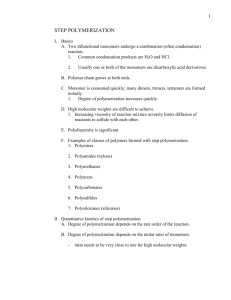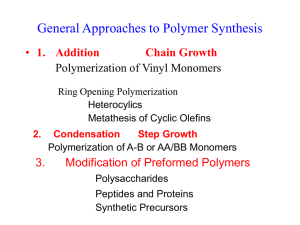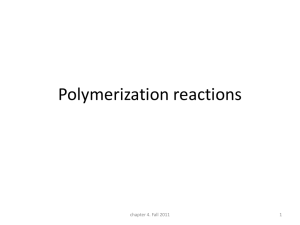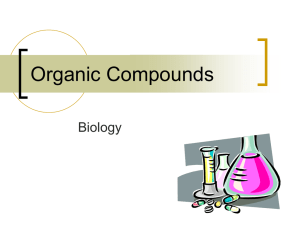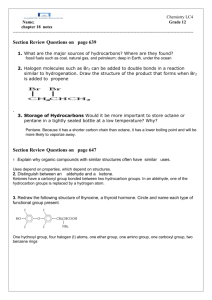Types of Vinyl Polymerization - LSU Macromolecular Studies Group
advertisement
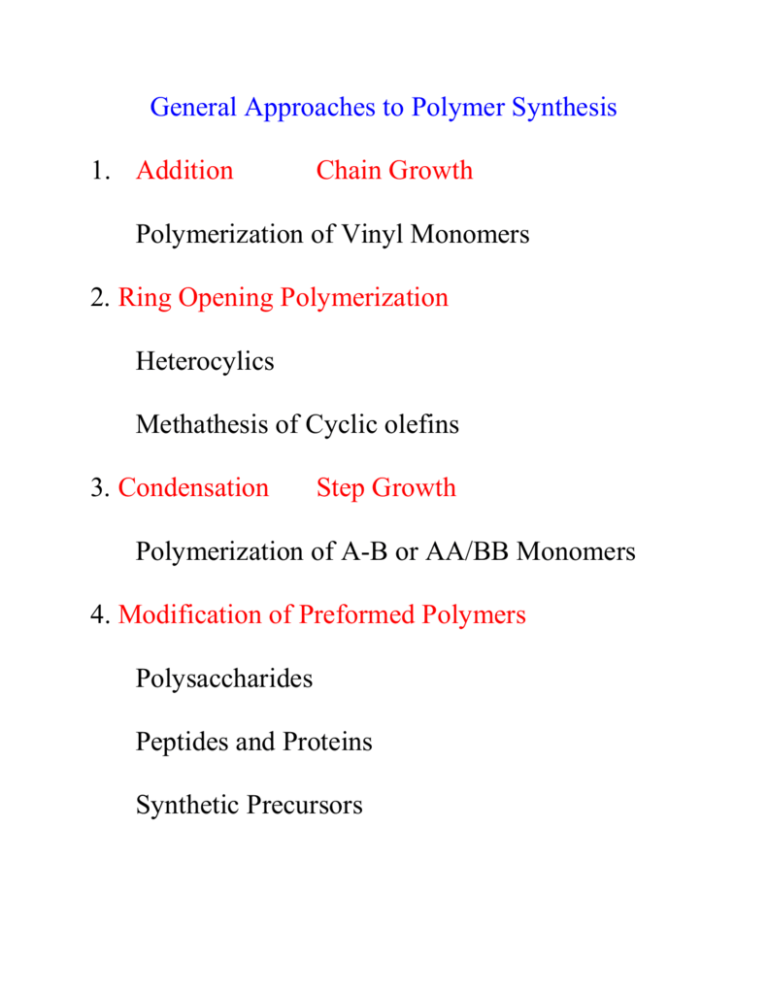
General Approaches to Polymer Synthesis 1. Addition Chain Growth Polymerization of Vinyl Monomers 2. Ring Opening Polymerization Heterocylics Methathesis of Cyclic olefins 3. Condensation Step Growth Polymerization of A-B or AA/BB Monomers 4. Modification of Preformed Polymers Polysaccharides Peptides and Proteins Synthetic Precursors Current Strategies in Polymer Synthesis Objectives: Precise Macromolecular Design 1. Control of: Molecular Weight Composition Sequence of repeat units Stereochemistry 2. Versatility Synthetic Methods 1. Step-growth (Condensation) Polymerization Mw/Mn 2 Statistical compositions and sequences 2. Chain-growth (Addition) Polymerization Mw/Mn > 1.5 2.0 Statistical compositions and sequences Little stereochemical control Major Developments in the 1950-60's 3. Living Polymerization (Anionic) Mw/Mn 1 Blocks, telechelics and stars available (Controlled molecular architecture) Statistical Stereochemical Control Statistical Compositions and Sequences Severe functional group restrictions 4. Ziegler-Natta (Metal-Coordinated) Polymerization Stereochemical Control Polydisperse products Statistical Compositions and Sequences Limited set of useful monomers, i.e. olefins Additional Developments in the 1980's 5. "Immortal" Polymerization (Cationic) Mw/Mn 1.05 Blocks, telechelics, stars (Controlled molecular architecture) Statistical Compositions and Sequences Severe functional group restrictions Under Development in the 1990's 6. "Living" Free Radical Polymerization Mw/Mn 1.05 Blocks, telechelics, stars (Controlled molecular architecture) Statistical Compositions and Sequences Broad range of monomers available 7. Single-Site Catalysis–Metal Coordinated II Enhanced Stereochemical control Variable stereochemistry in single molecule possible Narrow molecular weight distributions Improved control of copolymerization 8. Genetic approaches via Modified Microorganisms Monodisperse in MW Monodisperse in Composition Sequentially Uniform Stereochemically Pure Diverse set of functional groups possible Types of Vinyl Polymerization Advantage Bulk Simple Equipment Rapid reaction Pure polymer isolated Disadvantage Heat Buildup Gel effect Branching or crosslinking occurs Solution Good mixing Solution ready for application Lower molecular weight formed Low polymerization rate Solvent recovery required Suspension Low viscosity media Direct bead formation Removal of impurities Emulsion Low viscosity media Coagulation required to recover polymer High polymerization rate High molecular weight product High surface area latex Inverse Emulsion Water in Oil media Polymerization of water soluble monomers Emulsion inversion promotes polymer dissolution Latex stability HIGH PRESSURE POLYETHYLENE K. W. Doak, Encylopedia of Polymer Science, Vol. 6, 386-429 (1986) R H2C CH2 H3C 20-40,000 psi 150-325° C H3C CH3 H2C CH2 x H3C H3C C H2 CH3 H3C CH3 H3C CH3 Tubular Reactors with inner diameter of 2-6 cm and length of 0.5-1.5 km Residence Time 0.25-2.0 min. (linear velocity 10 m/sec) Initiator: Trace oxygen ( 300 ppm) plus alkyl peresters Chain Transfer Agents: butane, isooctane, propene, propionaldehyde Initial Temperature 140-180C Peak Temp. 300-325C Final Temp 250-275C Conversion: 15-20% per pass Molecular Weights: 20,000-100,000; MWD = 3-20 density = 0.91-0.93 g/cm3 Production in 2002 8 billion lbs. Applications: Film (60%) Injection molding 10-15%, Wire and Cable Insulation 5% Extrusion Coatings 10%, POLYSTYRENE Commercial Processes: 1. Solution High purity "crystalline" general purpose resin 2. Suspension Beads for insulation and ion-exchange resins 3. Emulsion ABS resins Solution Process: Solvent Ethyl Benzene 2-30% to control viscosity Initiators: Thermal, BPO, AIBN Conversion 60-90% depending upon reactor configuration Molecular weight: 50-150,000; MWD = 2-4 Tg = 85C Brittle, Low Solvent Resistance, Poor Weatherability About 7 billion lbs plastic resin and 2 billion lbs elastomers produced: only 1/3 are homopolystyrene. Applications: Injection molding, Extruded sheets, Expanded foams Production in 1999 6.5 billion lbs. Suspension (Pearl) Polymerization Process Type Aqueous Phase Monomers Used Product BEAD Polymer Soluble in Monomer 1% Sol. Polymer Suspending Agents Cu++ Inhibitors Suspending Agents Electrolytes Monomer Initiator Styrene Methyl Methacrylate Vinyl Acetate Clear Beads Vinyl Chloride Acrylonitrile Fluoroethylene Acrylamide Acrylic Acids Opaque Beads or Powders POWDER Polmer Insoluble in Monomer INVERSE Hydrocarbon Media Beads Emulsions Media to monomer ratio 3-4:1 Initiator must be soluble in monomer Initiation occurs in large (0.05-1.0 mm) monomer drop 107 radicals/droplet at stationary state Equivalent to a "mini-bulk" polymerization Aqueous (hydrocarbon) media provides good heat transfer Good particle size control through agitation and dispersion agents Control of porosity with proper additives and process conditions Product easy to recover and transfer Disadvantages: Suspending Agents contaminate product Removal of residual monomer necessary Suspension Polymerization of Styrene Aqueous Phase: Monomer Phase 16.6 Kg of H2O 0.24 kg Ca3PO4 0.14 kg Na+ Naphthalene sulfonate 0.077 kg. 15% Sodium Polyacrylate 16.6 Kg. Styrene (0.5 kg Methacrylic Acid) 0.012 kg AIBN 0.006 kg Benzoyl Peroxide 0.015 kg tert-Butyl Perbenzoate Temperature Program C Hours POLY(VINYL CHLORIDE) SUSPENSION PROCESSES Porous Beads Temperature Water 180 pt Vinyl Chloride 100 pt Polyvinyl 0.5 Alcohol, 80-90% Sodium ...0.03 Naphthalene Sulfonate Lauroyl Peroxide 0.5 Butane Conversion 3.0 Low 200 pt 100 pt 0.02 Polyethylene oxide 0.005 Diisopropyl 0.5 Percarbonate Decompress at 40-50% by removing 10% VCl Conditions at 40C 8 hr at 52C 75% of Poly(vinyl chloride) produced by suspension processes 10% by Pechiney Process 15% by Emulsion Processes 8 hr SUSPENSION POLYMERIZATION IN NON-AQUEOUS MEDIA Monomer Phase Conc. Aqueous Solution 40% Monomers Initiators Acrylamide Potassium Persulfate Acrylic Acids Hydrogen Peroxide Vinyl Pyrrolidone Redox Systems Quaternary Ammonium Monomers Suspending Media Hydrocarbon solvents Long Chain Alcohols Freons Supercritical CO2 Stabilizing Agents: Hydrophobic polymers containing hydrophilic functional groups Hydroxyethyl Cellulose Poly(vinyl ether-co-maleic anhydride) Sulfonate Polystyrene Sorbitol Oleate Hydrophobic Clays Silanized Silica Components of Emulsion Polymerization Monomer Polymer Monomer Droplet 500-2000 A Monomer Micelle 20 -30 A Monomer Droplet 10,000 A (1 ) Stages of Emulsion Polymerization Phase I Phase II Phase III Conversion Rate, P/t time Particles/ /ml Phase I Phase II Phase III Micelles 1017-1018 0 0 Monomer Droplets Polymer Particles 1011 1010 0 0 1015 1015 Micelles Size 25A Surfactant Molecules, 130 Monomer, 73 Water Monomer Droplets Size 10,000A 2.7 106 Radical Concentration 2.5 1010 1013 radicals/ml. sec EMULSION POLYMERIZATION Advantages: High rate of polymerization High molecular weights Few side reactions High Conversion achieved Efficient heat transfer Low viscosity medium Polymer never in solution Low tendancy to agglomerate Emulsified polymer may be stabilized and used directly Disadvantages: Polymer surface contaminated by surface active agents Coagulation introduces salts Poor electrical properties Kinetics of Emulsion Polymerization (Smith-Ewart Theory) Rp = kp [M]p [R.]aq where: [M]p = Conc. of monomer in polymer particle [R.]aq = Conc. of radicals in continuous (aqueous) phase = 1015 radicals/ml sec In practice both of these concentrations are constant during most of the polymerization Since the number of polymer particles, N = 1015 particles/ml On average, each particle received a new radical every 100 sec. One radical /particle allows only propagation Addition of second radical results in rapid termination Each particle is growing 1/2 of time At steady state: Rp of particles/2 = N kp [M] / 2 Molecular weight () of particles/ R. sec-1 = N kp [M] / Ri If N increases then DP increases! Most important variable Number of particles, N Depends upon: 1. Type and Concentration of Surfactant (Emulsifier) conc ranges from 1 - 8% relative to [M] Common surfactants: Dodecyl sulfonate or carboxylate (anionic) Nonylphenol-ethylene oxide adducts (neutral) Cationic surfactants are inhibitors! 2. Electrolyte Concentration High salt conc. decreases efficiency of surfactant 3. Rate of radical generation Redox systems most common 4. Temperature As temp. increases; kp and N increase but [M] decreases 5. Type and Intensity of Agitation Must maintain dispersion of monomer droplets 6. Monomer/water ratio controls heat transfer capacity Water must be dionized and degassed POLYMERS PRODUCED USING EMULSION PROCESSES Polymer Styrene-Butadiene Rubber Applications Tires, Belting, Flooring, Molded goods, Shoe soles, Electrical insulation Butadiene-Acrylonitrile (nitrile rubber) Fuel tanks, Gasoline hoses, Adhesives, Impregnated paper, leather and textiles Acrylonitrile-Butadiene-Styrene Engineering plastics, (ABS) household appliances, Automobile parts, Luggage Polychloroprene (neoprene rubber) Tires, Wire coatings, Belting, hoses, Shoe heels, Coated fabrics Polyacrylates Water based latex paints Poly(acrylic acid) Adhesives, Thickening agents, Poly(methacrylic acid) Ionomers Inverse Emulsion Process Polyacrylamide Thickening agents, Flocculants STYRENE-BUTADIENE "COLD" RUBBER "GR-S" Emulsion monomer Butadiene Styrene Water By Weight Based upon 100 pts 140 g 60 g 360-400 ml 70 Potasium Lauryl Sulfate Sodium Phosphate (pH = 10) 30 100-200 10.2 g 1.2 g 5.1 0.08 Versene - Fe +3 0.14 g FeSO4 ..0.1 g p-Menthane hydroperoxide 0.2 g 0.3 g HOCH2SO3- Na+ (Sodium formaldehyde sulfoxylate) 0.07 0.05 0.10 0.15 tert-Dodecyl Mercaptan 0.15 0.3 g Reaction Temp = 5C, Time = 12 hr. Shortstop with Inhibitors Then remove residual monomers by steam stripping (CH3)2N-C-S- Na+ S or Add antioxidants and antiozonants Two step coagulation 20 % NaCl Cream 5% H2SO4 Crumb HO OH Chemistry of Initiation . HOCH 2SO 2- Na+ RO -OH Fe ++ Fe +++ HOCH 2SO 2- Na+ RO . Versene complex + OH M RO -M . xM RSH ROM x M . RS. ROM x MH RS-M . xM RSM x M .

